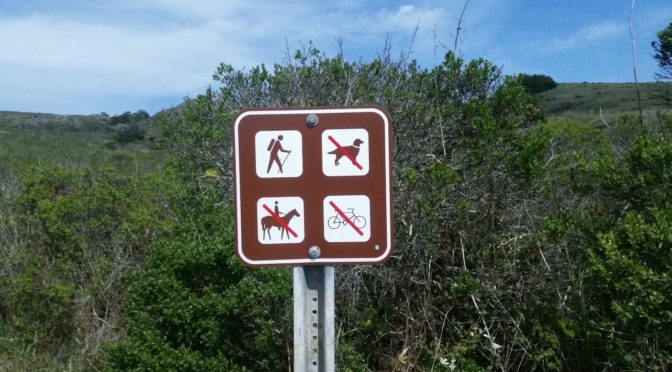I’m mostly a cyclist. I’d always rather bike than drive, and usually rather bike than walk. But sometimes, I do go for a walk, and this weekend I went for a hike on the Pomo Canyon trail in the Sonoma Coast State park. When I got there and walked past the no-bikes, no-dogs, no-horses sign, and it changed my mental state: the fact that I would not have watch out for anything other than pedestrians let me relax much more than I would on a multi-use trail. After a mile, I was zoned out into nature, watching a group of deer standing in the foggy morning mist, birds fluttering from bush to bush. It was a great escape from the hectic day to day of work and parenting two small children.
Then, “Excuse me!” from behind. Here comes two bicyclists, asking me to get out of the way. In the moment I was stunned, and just stepped off into the grass to let them go by. I didn’t get a very good look at them, but it was evident that they were not just people with bicycles but invested cyclists: gravel bikes, handlebar bags, Lycra. I have all that gear, and more. But I’d never think to bring it here.
On the way back out, past the no-bikes sign, I got a bit angrier. It’s a pretty prominent and unambiguous sign. When I got home and looked at the park map, it’s a fairly small park, and there are no multi-use trails, except for hiker-horse. There was was no other way in or out, or any way to mistakenly biking on a hiking-only trail. I became quite angry. Surprisingly angry.
A cyclist might think – as those cyclists apparently did – “Like, all you had to do was step aside into a grassy field for a minute, what’s the big deal?” I am a cyclist, and so I asked myself that question. The degree of my anger seemed strange even to me.
I kept mulling it over, and I realized how important and precious hiker-only status is. Not that every trail should be that way, or maybe even most trails, but it is very important that it exists somewhere. Enough somewheres so that if you want to seek it out, it’s there. It’s the same reason why National Wilderness Areas, without motor vehicles, exist as a subset of National Forest and BLM land. It’s really important to create the quietude, somewhere, where a person can go for a walk and know that there will be no vehicles or animals. As Aaron Teasdale, writing for Sierra magazine put it: “Just knowing bikers could be coming around the corner can add an ambient tension to a hike. Mountain bikers often tell hikers that to avoid problems all they have to do is stay alert, but that state of perpetual vigilance interferes with our ability to relax and appreciate the natural world.” If you read the rest of that piece it’s clear that Teasdale, like me, is quite sympathetic to bikes in the wilderness, but shares the view that hiker-only spaces are legitimate and important need.
My anger was also caused by the fact that the people who were violating this rule were cyclists who, of all people, should recognize the importance of use designations, because cyclists are so often on the wrong end of this dynamic. Recall what it’s like, biking in a designated bike lane, and then there’s person who has parked their car in that bike lane, or is driving through it. You have to get out of the way, even though you ought not to have to get out of the way. My anger towards cars in bike lanes, and my anger towards bikes on hiker-only trails, are species of the same genus. Another variety would be, as a mountain biker, encountering a motorcycle on your favorite hike-bike-horse trail. Teasdale again:
There’s a technological hierarchy of backcountry trail users, with the more mechanized negatively impacting the less mechanized. Social scientists call it an “asymmetric relationship.” . . . The [more mechanized] typically don’t mind encountering the lower ones, but the reverse is not true, especially as the number of users increase.
The generalized proposition from me is that it’s obnoxious when there is a planning and political process to allocate a specific strip of land for a particular form of transit, and then there’s somebody who thinks that they are special, those rules don’t apply to them, and they can bring a bigger, faster, more convenient vehicle. It’s selfish and antisocial.
So, please do not bike on hiker-only trails.

Leave a Reply